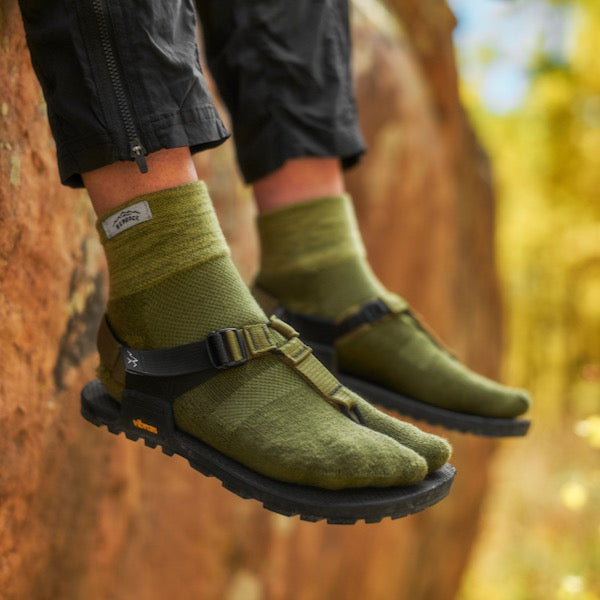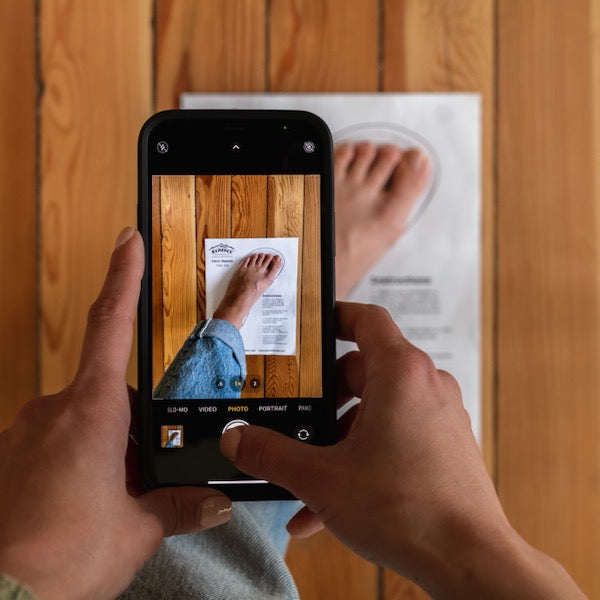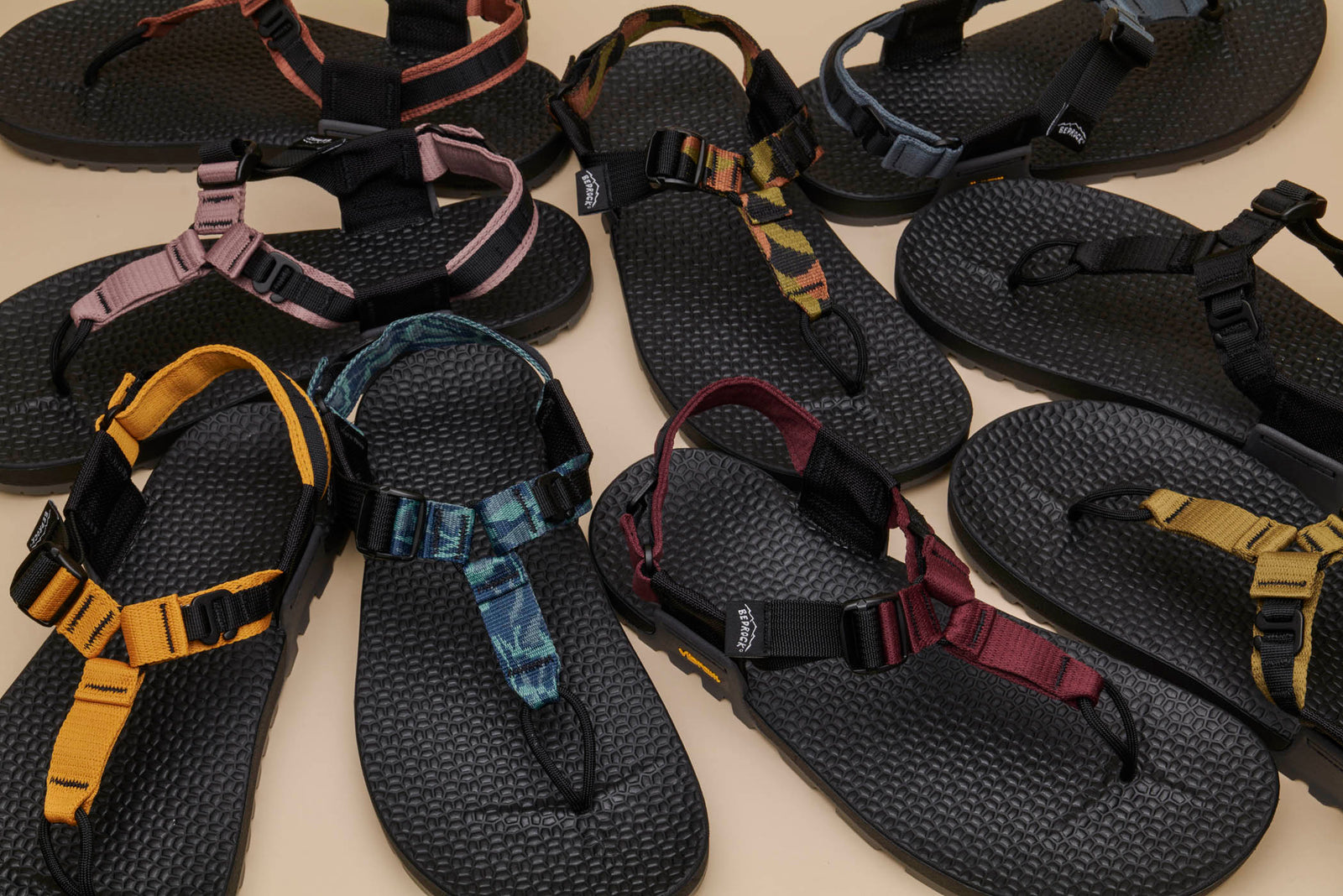Choosing to backpack in sandals invariably comes with a lot of questions from passerbys on the trail. Read on for Marie" Pebbles" Schrampfer's account of hiking the PCT in a pair of Bedrocks and the FAQ you can expect along the trail.

In 2023, I thru-hiked the Pacific Crest Trail.
In sandals.
In a single pair of sandals.


I wish I could say it’s because I’m really tough, or because I had some compelling point I was trying to prove. But really, it all comes down to the fact that I simply don’t like closed-toed shoes. I find sandals to be much, much more comfortable. And since I wear sandals so much in “real life” anyway, when I decided to thru-hike the PCT, it seemed only natural to do that in sandals, too. I ordered a pair of Bedrocks, tested them out on a short backpacking trip and a few walks around town, then headed to the southern terminus of the PCT and started hiking north. I had no idea how it was going to go. I had no clue how long I or my sandals would last. I certainly did not expect that 2,650 miles later, I’d finish my thru-hike having walked every single step of the way in that same pair of sandals.


As you can imagine, given the rugged landscape through which the PCT passes, and especially in light of the monstrous snowpack of 2023, I got a lot of questions about my footwear in the six months I was out there. In fact, I had to answer the question “Are you hiking in sandals…?” so many times that it almost earned me the trail name “Yes I Am.” Instead, I ended up as “Pebbles” after the character from the Flintstones – who, after all, live in the town of Bedrock. But that opening question was usually only the first of a deluge of others. There was the typical line-up, including queries as expected as “But what about rattlesnakes?” and “Aren’t you worried about frostbite?”


Then there was the occasional curveball, such as the unanticipated “Did you kick any cacti in the desert?” and “Whoah, can I take a picture of your feet?” (Believe it or not, I got that latter question twice.) Below, I’ve rounded up the most common of the many sandal-related questions I was asked during my thru-hike, together with some thoughts about hiking in sandals that emerged from my experience on the PCT. Hopefully, even the lingering sandal naysayers out there can find something amusing and enlightening in these words and the stories they tell. So without further ado, here are the FAQs from my PCT journey.

You’re wearing flip flops?
Let’s just get this one out of the way right at the beginning. I’m not sure if there’s one authoritative definition of “flip flops” out there, but at least in terms of the general connotation those words have, I’m pretty sure my Bedrocks don’t qualify. There’s a heel strap to keep each foot securely in place.
But what about *insert a particularly annoying terrain issue here*?
The PCT travels through some truly spectacular places. It thoroughly deserves its designation as one of America’s National Scenic Trails. But precisely because of its wild and remote character, the surface of the trail is often quite rough. To be sure, the PCT has some delightfully cruisy sections, but it also has a good number of segments that are anything but. So all along the trail, people who saw me hiking in sandals wanted to know, “What about the roots and branches and rocks all over the trail? Aren’t you stubbing your toes all the time?” “What about the poisonous plants that often crowd the trail: Poodle Dog Bush, Poison Ivy, and Poison Oak?” “What about all the blowdowns that you have to climb over and under and through?” In the low desert regions of southern California, people often asked, “What about the sandy trail debris getting in under your feet?” Further north in California (and let’s face it: pretty much everywhere in 2023) the question became, “What about all the snow?” Oregon hikers often inquired, “What about those fields of lava rock?” and hikers in Washington similarly wondered “What about the steep, rocky climbs of the North Cascades?” The rockiness of the trail proved to be a common theme among the questions I received throughout the Sierra Nevada as well – the last section of the PCT that I hiked. “What about the severe granite up here in the high country?” “What about the jagged ascent to the summit of Mt. Whitney?” “What about this rough, rocky, rugged trail?” Suffice it to say, the shape this basic question took varied as widely as the PCT’s stunning and ever-changing landscape.

All I could do then and all I can do now is speak from my own experience: I have yet to find any trail terrain that sandals can’t handle just as well as any other shoes. Sure, I got sandy trail debris under my feet (trail name “Pebbles,” remember?), but I also got it out from under my feet within a few steps. No, I don’t enjoy hiking endless miles on rock (quite the contrary, I assure you), but I haven’t met a single thru-hiker who does. Besides, my sandals have a grippy sole and an aggressive tread, so while I don’t prefer a rocky trail surface, I never once felt unsafe – not even winding my way up Mt. Whitney in the pre-dawn darkness to catch the September sunrise at the top.
I also suspect that because I hike in sandals, I watch my feet much more carefully than I would if I were hiking in closed-toed shoes. So no, I never had any uncomfortable encounters with encroaching poisonous plants. I only stubbed my toe three times during my entire thru-hike. And while I did have an annoying habit of stepping on sticks in just the right way to make the far end of the stick leap up and violently attack my other foot, the biggest issue of this sort was actually something no one ever asked me about. As I said, I was generally very attentive to where I placed each foot. I was less attentive, however, when I lifted my foot to take each subsequent step. So more often than I care to admit, as my rear foot came forward, the front of my sandal would catch on a fist-sized rock, lift the rock into the air, and fling it, with all the momentum of a thru-hiker’s vigorous pace, into the heel of my opposite foot. Now that, let me tell you, is not fun. It might even be my least favorite thing about hiking in sandals. But to be honest, that might be more of a clumsy me problem than a sandal hiking problem. I have a hunch that odd and obnoxious things like that would find a way to happen to me no matter what kind of footwear I was wearing. So if that’s the most annoying terrain issue the trail can throw at me, then I think I’ll keep hiking in sandals.

2023 was a ridiculously high snow year. What did you do in all that snow?
There was no escaping the snow on the PCT in 2023 – especially with the mid-March start date that I had. But as is so often the case in the world of thru-hiking, there’s nothing you can do but take things as they come and adapt to the situations in which you find yourself. So that’s what I did. I started my hike with two pairs of toe socks, figuring that I could either wear one pair or layer up both depending on the temperatures and snow conditions. And for the vast majority of the trail, that arrangement worked just fine. However, I learned in a snowstorm on my fourth day on the PCT – the one and only time I second guessed my decision to hike in sandals – that there would be occasions when my two pairs of toe socks wouldn’t quite be enough. So as I hunkered down with my trail family in Mt. Laguna to wait out the worst of that storm, I paid 20 cents for two plastic bags, pulled them on over my two layers of socks, secured the tops around my ankles with hair ties, and fully embraced my newfound hikertrash self.

Did you have any issues with your feet?
I had a few issues (find me someone who walks from Mexico to Canada and doesn’t), but nothing terribly significant. No major injuries, and – perhaps most surprising of all – only three tiny blisters in six months of nearly continuous walking. In my opinion, that’s a major pro of hiking in sandals. See, I noticed that blisters tended to develop on the feet of my hiking companions in two particular situations: first, when their shoes began to wear out, and second, when their feet got wet and stayed wet for long periods of time. In my case, my Bedrocks never wore out, so the first of those situations never applied. And the second situation only partially applied. With the abundant snow, rain, and river crossings, my feet got wet pretty frequently, just like everyone else’s. But unlike everyone else’s, my feet were out in the open air, so they dried extraordinarily fast. This means that I seldom experienced the lingering dampness that leads to blistering. Even on that day in southern California when we forded Mission Creek over thirty times, my feet remained comfortable and blister free. I might be the only thru-hiker who enjoyed Mission Creek day.
Just because blisters weren’t a problem, though, doesn’t mean I didn’t have other foot issues more particular to hiking in sandals. I certainly did. Indeed, my own nemesis was dry, cracked skin. When your feet are constantly exposed to the air – alternating between wet and dry again and again and again – your skin tends to dry out, and deep cracks can form that make each step feel like stepping on the blade of a knife. That’s even less fun than kicking a rock into your heel, and unfortunately, it’s a very real risk when hiking in sandals. Of course, there are always things you can do to mitigate risks. If you’re worried about blisters, you carry that roll of leukotape just in case; if you’re worried about cracked feet, you carry lotion and a foot buff no matter how many extra ounces they add to the weight of your pack. And you commit to using them regularly. Almost every night on the PCT, before I went to bed, I’d wash my feet, buff off any dry skin, slather on the lotion, then sleep in a thick pair of socks to keep the moisture in. With that foot care regimen, I still developed the occasional crack, but only three that affected my gait in any temporary but significant way. Considering how long and how consistently my feet were out there exposed to the elements, I think that’s pretty good.

Did you ever need microspikes?
Yes, I most certainly did. All throughout the high desert regions of southern California, like up and down the snowy Mt. San Jacinto. Again and again in early season northern California, when the trail was so buried in deep snow that my trail family and I were lucky if we could manage 10 miles per day. Around Crater Lake and Mt. Thielsen in Oregon, where significant snow lingered well into July. Like I said, I have yet to find any trail terrain that sandals can't handle.
Are you crazy?
I got this question fairly often, typically inflected with some variation of either profound awe or skeptical incredulity. But on one memorable morning in the snowy San Gabriel Mountains, it was my trail family – not me – who got asked this question by some passing hikers who had paused to gawk at my sandal-clad feet. Seeing our puzzled expressions, the hikers quickly explained: “Well, we already know the answer for her. She’s hiking in sandals. She’s clearly crazy! But as for you two who are hiking with someone hiking in sandals… you might still have some sanity left!” Post-trail, I can confirm: all three of us finished our hikes with our sanity perfectly intact.

So how many miles do you have on those sandals?
Miraculously, in that year of high snow, I was able to complete the entire PCT. In addition to all those PCT miles, these sandals have carried me for over 200 miles of side trails, pre-PCT hiking, and casual strolls around my neighborhood. That brings their total mileage up to well over 2,800.
Time for them to be Re-Souled? Or retired?
Maybe it’s time for another adventure.
















Glenn Zucman
June 27, 2024
Great story and helpful info (I have dry feet too!) Thank you for sharing and congratulations!